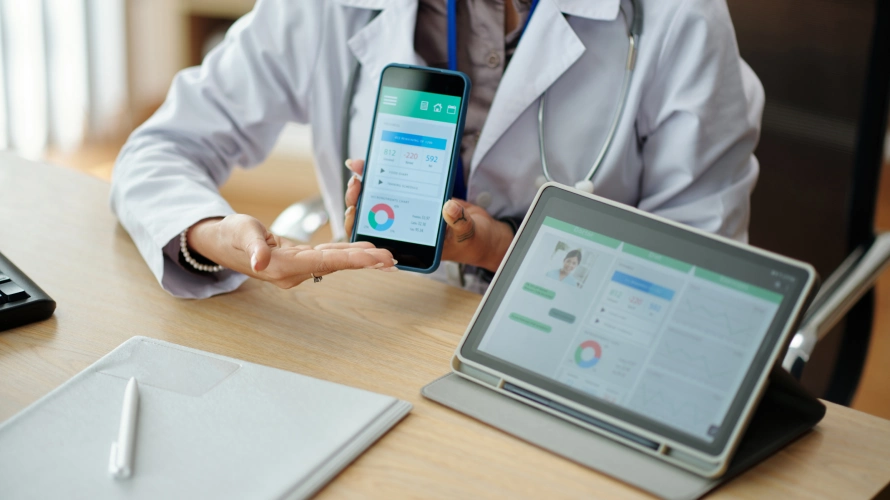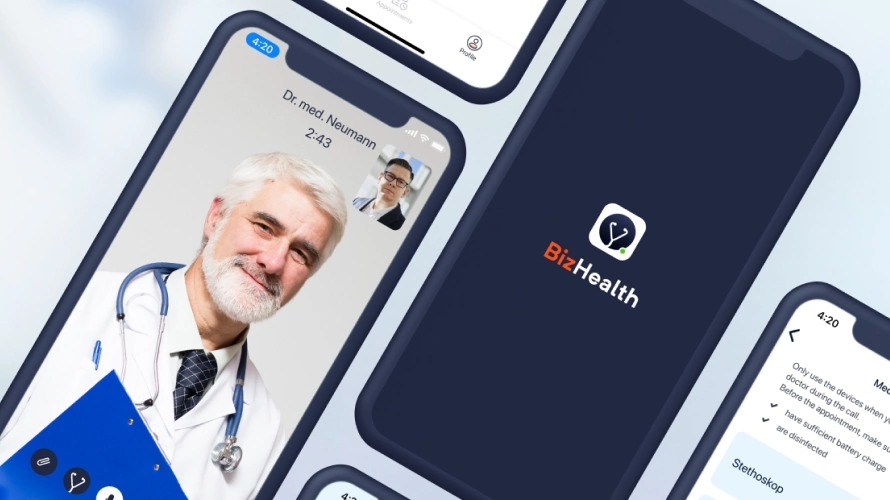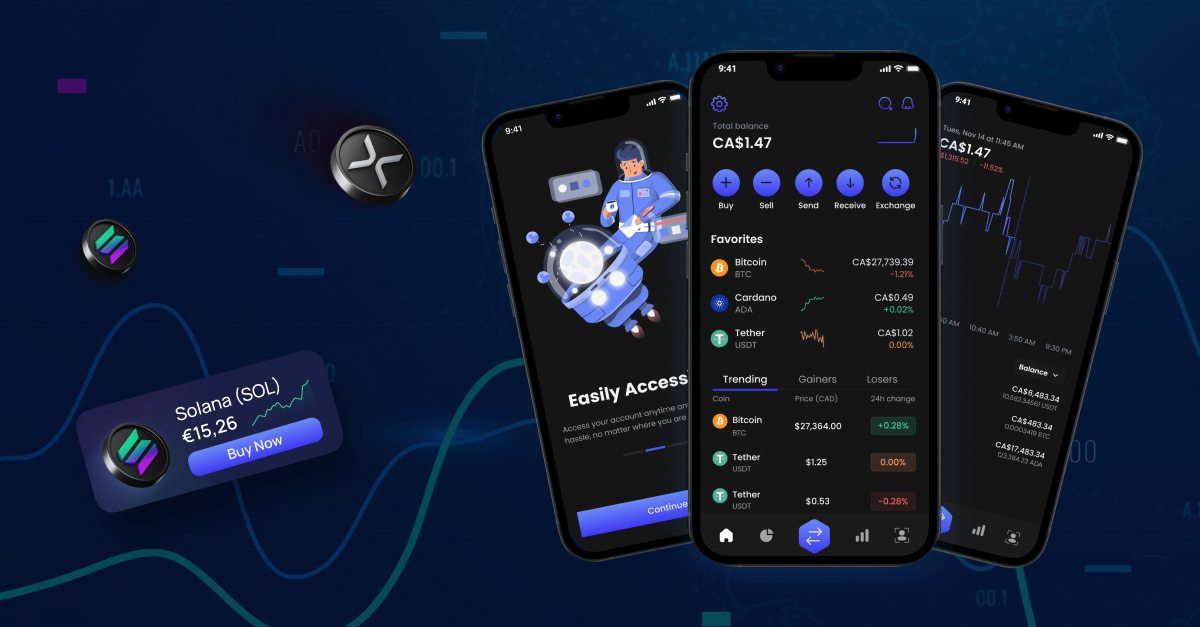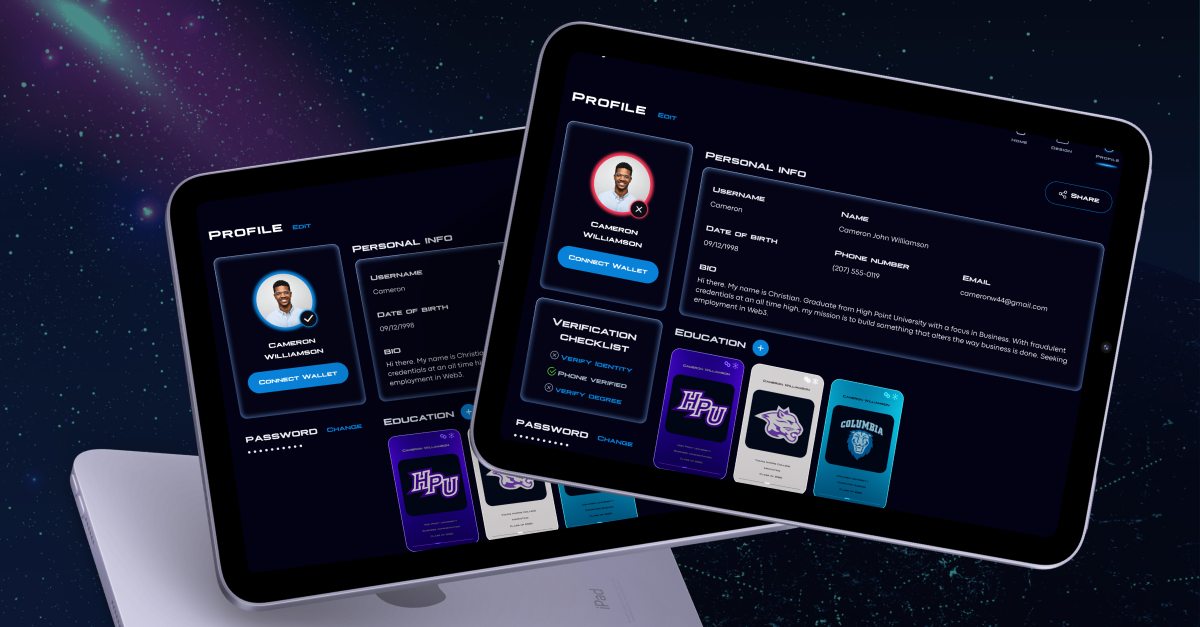Telehealth is a relatively new business model for the healthcare industry. However, its emergence and development were predicted almost 100 years ago. In 1925 Hugo Gernsback, a radio and publishing pioneer, published a bold article stating that there will be a technology allowing doctors to consult their patients remotely using a screen and robot arms. In 2023, telemedicine innovations have revolutionized the healthcare industry and continue to do so. In this article, we suggest dwelling on how to create a telehealth app, its benefits, costs and essentials.

So What is a Telehealth App?
A telehealth application is a solution that remotely connects doctors and patients. As a rule, these apps are powered by such technologies as video streaming, instant data transfer, and data analysis. With their help, a patient can get in touch with a doctor using video conferencing mode, share their health data gathered by the app and a wearable device, and discuss their health issues.
So, what might telehealth apps be? Below, we list the main types.
Store-and-Forward
The telehealth apps of this type are used as medical data storage. With their help, the patient can track their health issues and instantly share this information with the healthcare provider. For example, this is how an Electronic Health Record works. This healthcare system gathers and stores all the information about the patient’s medical history, treatment program, clinical trials results, and personal data.
Remote Monitoring Apps
With the help of the applications of this type, the patient can monitor their health and share the data with the doctor. In this case, healthcare professionals can also control the ways the patient follows a treatment program.
These solutions are relevant for post-surgery patients, those suffering from chronic health conditions, for example, chronic heart failure, and people with memory impairment. Remote monitoring apps are also often connected to wearable devices since the data generated by them can reveal even more insights for the doctors.

Real-time or Interactive Telehealth Apps
These are online (video) consultation apps that allow doctors and patients to get in touch instantly. Such apps are also often powered by the features to look for the suitable and available doctor, compare their ratings, leave users feedback and schedule the next online consultation.
According to the second approach to the remote healthcare services classification, they can be divided into the following categories:
On demand. Telehealth solutions for remote consultations are the most intuitive examples of on-demand healthcare services. The instant nature of medical assistance delivery is what makes them effective for both patients and doctors, promising business benefits for the app owner.
On-demand applications for different industries with instant value delivery are on the rise as well. Consider creating an on-demand mobile solution for your business – our tech experts will be glad to assist!
Self-care apps. With the help of these mobile applications, users can track their health by making notes on the medicines intake, diet, and activity (the latter can be tracked via a wearable device integrated with an app).
Mental health apps. There are also telemedicine apps that help patients with keeping track of and improving their mental health. As a rule, they come with self-diagnosis and self-monitoring features, plus the opportunities to get in touch with a psychologist. The most advanced apps use AI to provide data-driven suggestions and keep track of patients’ mental health changes based on their behavior within or beyond the app.
Ongoing care apps. These applications are valuable for chronic patients and those in need of ongoing medical care. In this case, ongoing care mobile apps are more cost-effective options since the patients can follow the treatment program at home but still under the therapist’s supervision.
According to Statista, the adoption rate of healthcare technology solutions is growing.
The trigger for their development and evolution is quite apparent. These are the Covid-provoked requirements for social distancing and urgent need for medical assistance. Experts suggest that the recent pandemic is the most crucial factor contributing to accelerated telehealth web & mobile app development, adoption, and utilization by patients and hospitals.
In 2020, telehealth solutions were on the rise as well, so below is a brief overview of the most popular mobile apps for health. P.S. You may use them as a part of your competitor analysis before getting started with building a telemedicine app.
Teladoc. This is an on-demand healthcare service that provides instant access to medical professionals. As for the unique features, the app offers ongoing care opportunities, plus consultation in dermatology and mental health.
Doctor On Demand. As the name suggests, this is another application for instant health consulting. The solution stands for the ultimate healthcare services and the opportunities for health challenges prevention. That’s why it provides lifestyle and nutrition consulting, mental health help, and family care services.
The Data-Driven Reasons to Build a Telehealth App in 2023
Telehealth software development is quite a promising business idea in 2023. According to Statista, the almost tenfold growth of the telehealth mobile app market can be expected in 10 years.
What’s more, the development of a telehealth mobile app promises many value-driving benefits for patients, doctors, and the creators themselves.
Benefits of a Telehealth App for Patients
Convenience. A well-developed mobile app is always a convenient option to solve everyday tasks. A telehealth product isn’t an exception.
Instant availability. The instant nature of on-demand medical services delivery is another telehealth app benefit for patients. This advantage is especially valuable for those with little health anxiety.
Medical services access equity. The usage of mobile apps for health makes access to medical services more equal for different groups of the population, including those from remote areas or areas with poor healthcare infrastructure development.
Better choices of doctors. Telehealth applications provide users with wide opportunities for the choice of the healthcare professional, being guided by the real reviews of previous customers.

Benefits of Telehealth Apps for Doctors
Data-driven insights. Mobile health applications can be perfectly integrated with wearable devices, Electronic Health Records, and health trackers. The data generated by these solutions can be insightful for therapists when developing a treatment program based on the patient’s medical history, lifestyle, and other specifics.
Improved recommendations. AI-assisted telehealth apps can promise even more valuable opportunities for doctors who can be guided by smart suggestions based on accurate data analysis.
Increased productivity and working schedule planning. According to the research, the work-life balance is one of the reasons doctors would like to adopt and use telehealth technologies.
Cost-effectiveness. Telehealth apps eliminate the necessity for administrative staff since the patients can schedule consultations themselves, choosing the time slots convenient for them.
Benefits for Investors and Developers
Join a trendy niche. Telehealth solutions are on the rise because of the health challenges the whole world has to deal with right now. Creating a custom telehealth app can become your contribution to the global goal.
Develop a new business model. Most telemedicine applications charge users for the time the doctor has to spend on their consulting. This is quite an obvious business model, which means that you can suggest a more winning option in terms of cost, effectiveness, and user experience.
Create an ongoing income stream. Health issues and concerns will always be relevant, so the telemedicine niche can be considered an evergreen one. A well-developed and designed mobile app with a clear and perfectly targeted value proposition can become another source of ongoing income.
The readiness for telemedicine adoption among patients and doctors is one more reason to create a telemedicine app. According to the survey, 55% of patients find telemedicine applications a worth considering option compared to the usual visits to the hospital.
The recent research among doctors has also shown that 69% of them are willing to adopt telemedicine technologies. The top reasons shared by them are the opportunity to improve medical services access, achieve work-life balance, attract new patients, improve clinical outcomes, and keep pace with the times.
Despite positive user sentiments, there are still some external and internal limitations to telehealth software development and adoption. The external factors that interfere with this technology utilization are lack of Internet coverage and access to smart devices. The population of developing countries also lacks a literacy and health prioritization mindset, despite being just the user group in the most need of high-quality medical services.
How to Create a Telehealth App Step by Step
Here is how to create a telehealth application step by step, following the Agile and LEAN methodologies.
-
Research the Market
The development of any solution begins with careful market research. Firstly, this is one of the core approaches of the LEAN methodology, according to which you have to learn, test, measure, and invest step by step. Secondly, this is an opportunity to get a clear idea of the market you will enter and start brainstorming the ideas to make your telemedicine application outstanding and demanded by future users.
-
Develop Value Proposition
How to develop a telehealth app with great market potential? Based on the market research, you have to build a clear and unique value proposition. That is, you have to perfectly match the pain point of the users you have researched at the previous stage with a unique opportunity to solve it with the help of your app. To come up with such a value, be guided by the competitor analysis and user-generated feedback. Also, don’t hesitate to suggest non-standard way outs since, most frequently, they come with excellent potential.
-
Shortlist the Essential Features for MVP
At this stage, create a list of essential features that will power your Minimum Viable Product. As a rule, these are the basic functions that make the interaction with the application possible, plus something unique and value proposition-driven.
-
Think about the Design and UI
Our healthcare app development services in telemedicine solutions development suggests that many of the apps for this industry come with too complex design and non-intuitive UI. But when it comes to on-demand applications, each UI and design element should contribute to the instant value delivery. At this stage, do your best to suggest the design and UI solutions that will make the interaction with the app seamless, effective, and outstanding at the same time.
-
Hire a Development Vendor
Make sure to consider the development companies with particular experience in creating mobile apps for healthcare. The smart choice of the development vendor will allow you to reuse their knowledge, experience, and best practices in creating your solution and save some time and money by avoiding costly mistakes.
-
Create and Test Your MVP
After you are done with the preparatory steps, let the technical and the most fascinating part of the development process begin. At this stage and with the support of your development vendor, you will have to build the first version of an MVP.
This is a demo solution with essential features only that is tested with real users. The feedback you gather from them can promise a lot of business value since creating something your users have asked for is the only right way to match your product with their expectations and meet market demand.
-
Gather Feedback and Improve
You got it right — after you have analyzed the insights your users have shared at the stage of MVP testing, prioritize their ideas and implement them step by step.
-
Add Advanced Features
Below, we will suggest some ideas on how to build a telemedicine app in a more advanced way. You are welcome to consider them for your project development, add some specifics, validate and create additional features for your app.
-
Stay Focused on Security and Legal Compliance
This is one of the essential points you should always keep in mind when creating a solution for the healthcare industry. Medical data is very sensitive and very expensive on the black market, so making its protection one of your priorities is always the right approach. Also, you should take legal compliance into account.
Health Insurance Portability and Accountability Act (HIPAA) is one of the main legal documents you have to follow. It establishes data management and protection practices in the field of healthcare.
-
Grow and Scale
This is the final but not the last step of your telemedicine solution development. At the growth stage, you still have to stay tuned into your users’ feedback, monitor how they actually use your app, uncover the behavioral patterns and look for ways to add even more value for both groups of users. From the technical perspective, you will have to maintain and support your solution, ensuring its seamless and safe work.
Telehealth App Features
Below is the list of telemedicine app features you can build for MVP, plus some suggestions on how to create a telemedicine app with more advanced functions.
Features for patients
Features for doctors
Sign in/registration
Sign in/registration
Personal profile
Personal profile
EHR integration
EHR integration
Search for doctor/service
Scheduling/ confirming a booking
Scheduling
Recurring consultations appointments
Text and video communication
Text and video communication
Notifications
Notifications
Reviews
Medical knowledge database
Optionally:
- self-diagnosing tools;
- wearable device integration;
- heath and lifestyle trackers.
Optionally:
- AI-powered assistance;
- clinical outcomes analysis;
- statistics and reporting.
Tech Stack Used in Telehealth Software Development
Skilled and experienced healthcare software developers know how to develop a telemedicine app and ensure its proper and seamless work. Let’s find out what technical features, tools, and programming languages to consider during healthcare software development.
Programming languages (based on the type of platform):
- Swift (iOS);
- Kotlin, Java (Android);
- Flutter, React Native (cross-platform).
Front-end development
The front end is the client side of a telemedicine application; it includes all the parts users interact with. To create a telemedicine app, front-end developers use the following programming languages, frameworks, and libraries:
- Programming languages: JavaScript, Python, HTML.
- Frameworks: React Native, AngularJS, VueJS.
- Libraries: React, ReactJS, jQuery.
- Deployment: Vercel, Netlify, AWS S3.
- Design libraries: Bootstrap, Ant Design.
Back-end development
The back end is the server side of a telehealth app, ensuring the proper work of the front-end. To develop a telehealth app, developers use the following programming languages, databases, and tools:
- Programming languages: Java, Ruby, Node.js, PHP, C++.
- Databases: MySQL, PostgreSQL, MongoDB.
- Telehealth SDK, APIs, and Frameworks: Stripe, EC2, S3.
- Payment gateways: PayPal, Braintree, Stripe.
- For video calls: RTMP, Twilio, WebRTC.
- For Chat: Twilio, Socket.io.
- Deployment platforms: Google Cloud, Vault, AWS, Terraform.
7 Trends in Telehealth App Development
How to create a telehealth app that brings value and profit? The answer is integrating modern technologies and features that guarantee a pleasant user experience and enhance treatment effectiveness.
-
Artificial Intelligence and Machine Learning
Artificial Intelligence (AI) helps create individualized treatment plans, diagnostic tools, and predictive analytics solutions. Thanks to generative AI in healthcare, some illnesses, like cancer, can be detected years earlier compared to traditional diagnostic methods. The use of AI speeds up disease detection and enhances overall care quality.
-
IoMT
Internet of Medical Things (IoMT) devices are used to monitor patients’ health remotely and manage medical equipment and hospital infrastructure. With the help of wearables, doctors can collect health data and adjust treatment accordingly, monitor patients’ vitals, and detect abnormalities. Telehealth apps connected with IoT for medical devices can assist in treating older people, people with disabilities, and at-risk populations.
-
Big Data
Telehealth applications deal with large volumes of health data, such as medical records, statistics, medical reports, and other documents. That’s why it’s important to grant seamless and easy access to reliable databases. Big data provides innovative analytics tools, improving the accuracy of diagnostics and quality of treatment while reducing costs.
-
Cloud Transformation
Serverless architecture uses cloud-based services to store and retrieve large amounts of medical data. This facilitates data analytics and collaborative research. Salesforce Health Cloud helps reduce costs, improve efficiency, and ensure data security and scalability.
-
Blockchain
Blockchain technology provides unprecedented user data security while making the data exchange more transparent, collaborative, and trustworthy. Besides, blockchain ensures traceable and secure transactions, which can be useful regarding medical billing and payment.
-
Machine Learning
Machine learning (ML) algorithms are able to analyze big data and spot patterns that might have been missed due to human error. This improves diagnosis accuracy and reduces healthcare expenses.
-
VR/AR
Virtual Reality (VR) and Augmented Reality (AR) provide new opportunities for remote and collaborative learning and training of medical professionals. Virtual reality in surgery training creates a mistake-friendly environment, allowing surgeons to practice their skills in realistic virtual ecosystems. This improves the quality of care, provides room for practice, and increases the chances of successful operations.
5 Ways to Monetize Your Telemedicine App
How to build a telehealth application that is not only effective but also generates profit? This question bothers anyone starting a telemedicine business. Below, we list the main types of monetization in medical website development.
Fees
The most common and easiest way of monetizing telehealth apps is through visit fees. In this model, the app charges patients a certain fee when paying for an online doctor’s consultation. The fee amount can vary depending on the type and duration of the consultation, the qualification and location of the doctor, etc.
Freemium
A freemium model provides an application with the basic telemedicine app features and functionalities free of charge, while more enhanced features are available only on a paid basis. In most cases, users are offered a free trial period so that they can see what they will be paying for. After the subscription, the users gain access to premium features, advanced functionality, and customization options.
Subscription
Paid subscriptions are a popular choice among healthcare app creators as they provide a predictable and steady revenue stream needed for app maintenance. Generally, there are two types of subscriptions: monthly and annual. The subscription fees can be charged to different user categories. For instance, a telemedicine app can charge healthcare providers and doctors a listing fee for being featured on the app. Many telehealth apps like Teladoc generate income through insurance plans, so payments come from employers across the USA.
In-App Purchases
In-app purchases are a great way of monetization if you plan to develop a free app. In this way, the application works as a marketplace featuring relevant products or services. For example, users can buy medications and nutritional supplements, book and prepay doctor appointments, doctor on demand therapy sessions, and have their prescriptions refilled. However, you shouldn’t entirely rely on in-app purchases as the primary monetization model.
In-App Advertising
Advertisements can be quite frustrating to some telemedicine application users. Therefore, ads should be relevant and not excessive so as not to disrupt user experience. In-app advertising typically works on a pay-per-view and pay-per-click basis. Mobile advertising providers can generate real-time targeted ads using technologies like Beacon, NFC, or RFID. In this way, users can see ads for products and services in their residential area and are more likely to click on them.
How Much Does it Cost to Create a Telehealth App?
How much does it cost to create a telehealth app? The final cost estimate largely depends on the features set you want to embed, their complexity and specifics, design, possible development challenges, and pitfalls, plus the location of your development vendor.
Also, keep in mind that estimating the cost of MVP development is quite possible for an experienced software development company. However, forecasting the accurate cost of the final solution can be tricky since the full-fledged set of features largely depends on the results of your MVP testing and users’ feedback.
According to our experience, the cost to create a telehealth app may approximately reach:
- $50,000 to $60,000 for MVP development;
- $100,000-$200,000 for full-fledged solution development.
Below is the list of the specialists you need to hire for this type of project. The final price also depends on the business model you use to source your development project with the necessary talents and the actual amount of time they spend on your solution creation.
- Project Manager;
- Researchers and Business Analysts (BA);
- Developers;
- Designers;
- QA and testers;
- Marketers;
- Legal compliance and security consultants.
Would you like to get a more accurate cost breakdown for your telemedicine MVP?
Our Experience: How to Create Mobile Telehealth App
At Interexy, we are proud to have been developing an innovative telehealth solution that has raised 1.7 million euros in 5 months after an MVP launch.
MedKitDoc

MedKitDoc is an industry-disrupting healthcare application with features that go beyond video consultation only. With the set of connected medical devices, it allows for remote blood pressure, temperature, and pulse oximetry control.
Integrating different hardware was one of the biggest challenges in MedKitDoc development. We also had to ensure seamless, instant, and safe data transfer, plus think about making the app usage intuitive for both doctors and patients. To date, MedKitDoc is growing and scaling, pursuing the goal of revolutionizing telehealth.
Physact

The Physact was designed as a convenient platform for patients struggling with depression. The key idea behind the app was to allow doctors to treat depression based on a Swedish physiotherapy program.
As a telemedicine app development company we will be excited to create a top-notch telemedicine solution for your business as well! You are welcome to share your ideas with Interexy!
Final Thoughts
Developing a solution for the telehealth industry is a winning opportunity in the long run. With the help of such an app, you will help others live in their best health possible by providing them with instant and safe medical services. Supported by the trusted development vendor, you will also be able to create a top-notch solution with great market and revenue-driving potential.
FAQs
-
What does an average telemedicine app consist of?
Typically, an average telemedicine app consists of a mobile/desktop/web app for patients, a back end with a database, a web app for app admins, and a mobile/desktop/web app for doctors.
-
How much does it cost to create a telehealth app?
The telemedicine app development cost can range from $50,000 to $60,000 for MVP development and $100,000-$200,000 for full-fledged solution development. The final cost of the application is individual, as it depends on many factors, such as app features and functions, design requirements, the app’s complexity, technology stack, the location and size of the team involved, third-party integrations, and much more.
-
How long does it take to develop a telemedicine app?
On average, it will take about 6-18 months to build a telemedicine application. The telehealth app development time depends on the app’s complexity, the amount of dashboards and features required, the skills of software developers, etc.
-
How to build a telemedicine app that brings profit?
There are five most popular ways to make a profit from your telemedicine app. You can offer a freemium version of the app with basic functionality and features and a more sophisticated and advanced version available on subscription. Another option is to collect fees; in this way, you get a percentage of the cost of the doctor’s visit. In addition, you can integrate the features of a marketplace and provide an opportunity to make in-app purchases. In-app advertising is another way of app monetization that works on a pay-per-view and pay-per-click basis.







